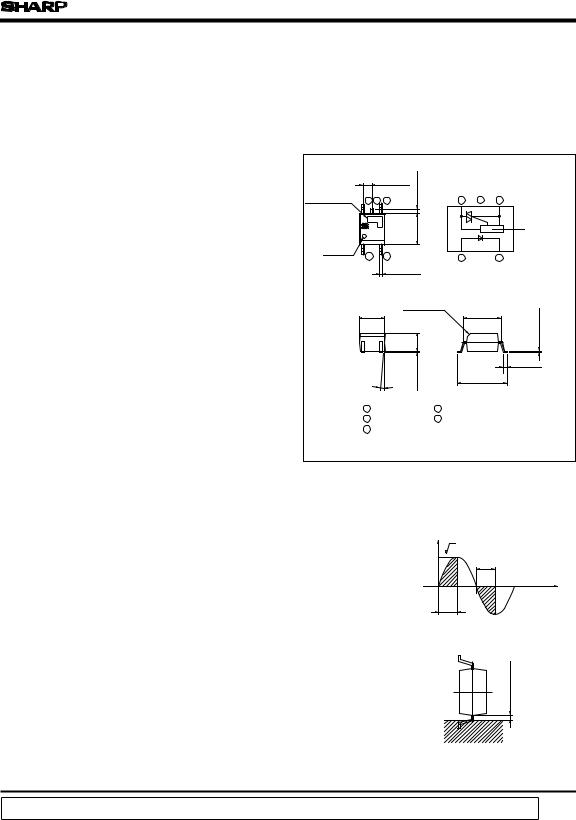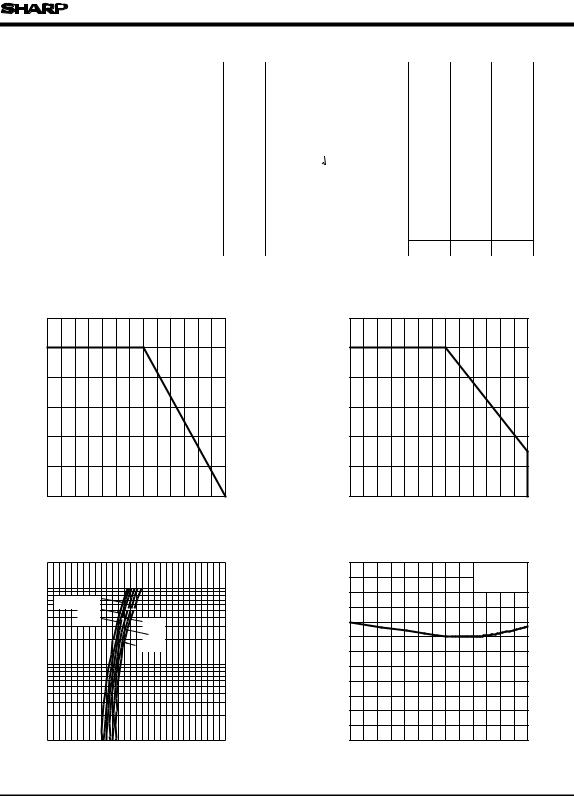Sharp S11MS3, S21MS3, S21MS4 Datasheet

S11MS3/S21MS3/S21MS4
S11MS3/
S21MS3/S21MS4
■ Features
1. Ultra-compact, mini-flat package type ( 3.6 x 4.4 x 2.0mm)
2. Built-in zero-cross circuit
(S21MS4 )
3. High isolation voltage between input and output (Viso : 3 750Vrms )
4. Recognized by UL, file No.E64380
■ Model Line-ups
|
|
For 100V lines |
For 200V lines |
No built-in |
|
S11MS3 |
S21MS3 |
zero-cross circuit |
|
||
|
|
|
|
Built-in |
|
- |
S21MS4 |
zero-cross circuit |
|
||
|
|
|
|
■ Applications |
|
|
|
1.For triggering of medium/high power triacs
High Density Surface Mount Type
Mini-flat Package
Phototriac Coupler
■ Outline Dimensions |
|
|
(Unit : mm ) |
|||||
|
1.27± 0.25 |
|
MAX. |
Internal connection |
||||
|
|
diagram |
|
|||||
|
|
|
|
|
|
|||
|
|
|
|
|
|
|
|
|
Model No. |
6 5 |
4 |
|
0.6 |
6 |
5 |
4 |
|
|
|
|
||||||
|
S |
|
|
|
0.2 |
|
|
|
|
|
|
|
|
± |
|
|
Zero-cross |
Anode |
|
|
|
4.4 |
|
|
||
|
|
|
|
|
circuit |
|||
|
|
|
|
|
|
|||
mark |
1 |
|
3 |
|
|
1 |
|
3 |
|
|
|
|
|
||||
|
|
|
0.4± 0.1 |
|
|
|
|
|
|
3.6± 0.3 |
|
C0.4 |
|
5.3± 0.3 |
|||
|
Input side |
|
||||||
|
|
|
|
|
|
± 0.05 |
||
|
|
|
|
|
0.2 |
|
|
|
|
|
|
|
|
± |
|
|
0.2 |
|
|
|
|
|
2.6 |
|
|
|
|
|
|
|
|
±0.1 |
|
|
0.5+- 0.20.4 |
|
|
|
|
|
|
7.0+- 0.70.2 |
|
|
|
|
|
|
|
0.1 |
|
|
|
|
|
|
|
|
|
|
|
|
|
|
6 ˚ |
|
|
|
|
|
|
|
1 |
Anode |
|
5 |
No external connection |
|||
|
3 |
Cathode |
6 |
Anode/ |
|
|||
|
4 |
Anode/ |
|
|
cathode |
|
||
|
|
cathode |
|
|
|
|
||
|
Zero-cross circuit for S21MS4 |
|
|
|||||
■ Absolute Maximum Ratings |
|
|
|
|
( Ta = 25˚C) |
||
|
|
|
|
|
|
|
|
|
Parameter |
Symbol |
|
Rating |
|
Unit |
|
|
S11MS3 |
|
S21MS3/S21MS4 |
||||
|
|
|
|
|
|||
Input |
Forward current |
IF |
|
50 |
|
mA |
|
|
|
|
|||||
|
Reverse voltage |
VR |
|
6 |
|
V |
|
Output |
1 RMS ON-state current |
IT |
|
0.05 |
|
A rms |
|
2 Peak one cycle surge current |
Isurge |
|
0.6 |
|
A |
||
|
|
|
|||||
|
Repetitive peak OFF-state voltage |
VDRM |
400 |
|
600 |
|
V |
|
3 Isolation voltage |
Viso |
|
3 750 |
|
Vrms |
|
|
Operating temperature |
Topr |
- 30 to +100 |
|
˚C |
||
|
Storage temperatrue |
Tstg |
- 40 to +125 |
|
˚C |
||
|
4 Soldering temperature |
Tsol |
|
260 |
|
˚C |
|
1 The definition of conduction angle θ of effective ON current IT should be as shown in the right drawing.
2 50Hz sine wave
3 40 to 60% RH, AC for 1 minute4 For 10 seconds,
IT |
2 • IT |
θ1, θ2<= 90˚ |
|
|
θ2 |
|
|
(A) |
|
180˚ |
|
|
|
|
|
0 |
90˚ |
360˚ |
θ |
|
θ 1 |
|
|
Soldering area
0.2mm or more |
“ In the absence of confirmation by device specification sheets, SHARP takes no responsibility for any defects that occur in equipment using any of SHARP's devices, shown in catalogs, data books, etc. Contact SHARP in order to obtain the latest version of the device specification sheets before using any SHARP's device”.

S11MS3/S21MS3/S21MS4
■ Electro-optical Characteristics |
|
|
|
|
|
|
|
(Ta= 25˚C) |
||||
|
|
|
|
|
|
|
|
|
|
|
|
|
|
Parameter |
|
Symbol |
Conditions |
MIN. |
TYP. |
MAX. |
Unit |
||||
Input |
Forward voltage |
|
VF |
IF = 20mA |
- |
1.2 |
1.4 |
V |
||||
Reverse current |
|
IR |
VR = 3V |
- |
- |
10 |
μA |
|||||
|
|
|||||||||||
|
Repetitive peak OFF-state current |
I DRM |
VDRM = Rated |
- |
- |
1 |
μA |
|||||
|
ON-state voltage |
|
VT |
IT = 0.05A |
- |
- |
2.5 |
V |
||||
Output |
Holding current |
|
IH |
VD = 6V |
0.1 |
- |
3.5 |
mA |
||||
Critical rate of rise of OFF-state voltage |
dV/dt |
V DRM = 1/ |
|
|
• Rated |
100 |
1 000 |
- |
V/ μ s |
|||
|
|
2 |
||||||||||
|
|
|||||||||||
|
Zero-cross |
S21MS4 |
VOX |
IF = 15mA, Resistance load |
- |
- |
35 |
V |
||||
|
voltage |
|||||||||||
|
|
|
|
|
|
|
|
|
|
|
||
Transfer |
Minimum trigger current |
I FT |
VD = 6V, RL = 100Ω |
- |
- |
10 |
mA |
|||||
Isolation resistance |
RISO |
DC500V, 40 to 60% RH |
5 x 1010 |
1011 |
- |
Ω |
||||||
charac- |
|
|
|
|
|
|
|
|
|
|
|
|
|
S11MS3/S21MS3 |
|
VD = 6V, RL = 100Ω , |
- |
- |
100 |
μ s |
|||||
teristics |
Turn-on time |
t on |
||||||||||
S21MS4 |
IF = 20mA |
- |
- |
50 |
||||||||
|
|
|
|
|||||||||
Fig. 1 RMS ON-state Current vs. Ambient Temperature
|
60 |
|
|
|
) |
50 |
|
|
|
rms |
|
|
|
|
|
|
|
|
|
mA |
|
|
|
|
( |
40 |
|
|
|
T |
|
|
|
|
|
|
|
|
|
I |
|
|
|
|
-state current |
30 |
|
|
|
20 |
|
|
|
|
RMS ON |
|
|
|
|
10 |
|
|
|
|
|
|
|
|
|
|
0 |
|
|
|
|
-30 |
0 |
50 |
100 |
|
|
Ambient temperature T a (˚C) |
|
|
Fig. 3 Forward Current vs.
Forward Voltage
|
200 |
|
|
|
|
|
|
|
100 |
|
|
|
|
|
|
) |
50 |
T a = 100˚C |
|
|
|
|
|
75˚C |
|
|
|
|
|
||
mA |
|
|
|
|
|
||
|
50˚C |
|
|
25˚C |
|
|
|
( |
|
|
|
|
|
|
|
F |
20 |
|
|
|
0˚C |
|
|
I |
|
|
|
|
|
||
current |
|
|
|
- 30˚C |
|
|
|
|
|
|
|
|
|
||
10 |
|
|
|
|
|
|
|
Forward |
|
|
|
|
|
|
|
5 |
|
|
|
|
|
|
|
|
|
|
|
|
|
|
|
|
2 |
|
|
|
|
|
|
|
1 |
|
|
|
|
|
|
|
0 |
0.5 |
1.0 |
1.5 |
2.0 |
2.5 |
3.0 |
|
|
Forward voltage V F (V) |
|
|
|||
Fig. 2 Forward Current vs.
Ambient Temperature
|
60 |
|
|
|
|
50 |
|
|
|
) |
|
|
|
|
mA |
40 |
|
|
|
( |
|
|
|
|
F |
|
|
|
|
I |
|
|
|
|
current |
30 |
|
|
|
|
|
|
|
|
Forward |
20 |
|
|
|
|
|
|
|
|
|
10 |
|
|
|
|
0 |
|
|
|
|
- 30 |
0 |
50 |
100 |
|
|
Ambient temperature T a |
(˚C) |
|
Fig. 4-a Minimum Trigger Current vs.
|
Ambient Temperature |
|
|
||||
|
12 |
|
|
(S11MS3/S21MS3) |
|||
|
|
|
|
|
V D = 6V |
|
|
|
|
|
|
|
|
|
|
|
10 |
|
|
|
|
R L = 100Ω |
|
) |
|
|
|
|
|
|
|
mA |
|
|
|
|
|
|
|
( |
|
|
|
|
|
|
|
FT |
8 |
|
|
|
|
|
|
current I |
6 |
|
|
|
|
|
|
trigger |
4 |
|
|
|
|
|
|
Minimum |
|
|
|
|
|
|
|
2 |
|
|
|
|
|
|
|
|
|
|
|
|
|
|
|
|
0 |
0 |
20 |
40 |
60 |
80 |
100 |
|
-30 |
||||||
|
|
Ambient temperature T a (˚C) |
|
||||
